UMS Artists in “Residence”: Spring 2015 Update!
In fall 2014, UMS launched a new Artist in “Residence” program. Five local artists were chosen to take “residence” at our performances. It’s been a pleasure getting to know this cohort throughout the year and exciting to see how UMS performances have helped inspire new works!
Curious what they’ve been up to? Check out the AiR update below, and come chat with the artists in residence in person at our 2015-2016 Season Launch Party on Friday, April 24, 2015 from 5-7:30 pm in Ann Arbor’s Rackham Graduate Building.
Our Artists in Residence have been busy. Have you heard the news?!
Playwright, actor, director, and teaching artist Emilio Rodriguez is co-producing the Metro Detroit Fringe Festival in late June. His play “Swimming While Drowning” will have a reading at the Activate Midwest festival at Western Michigan University in June and also by the Latino/a Theatre Commons in Chicago in July.
Writer Robert James Russell just released his chapbook of short stories Don’t Ask Me to Spell It Out. His next book, a Western called Mesilla —is due out this fall.
Additionally, Russell will be joining the New Harmony Writers Workshop as a Fellow this June at the University of Southern Indiana. He is also honored to be leading two writing workshops in May and June at the Great Lakes Commonwealth of Letters (GLCL) in Grand Rapids.
Pianist Nicholas Gable is thrilled to announce a tentative chamber music performance list: (dates TBA)
César Franck’s Violin Sonata in A Major
Sergei Rachmaninoff’s G Minor Trio (Elégiaque)
Rachmaninoff’s Cello Sonata in G Minor
Painter, drawer, and sculpturist Carolyn Reed Barritt’s artwork was chosen to be reproduced on vinyl and installed on a traffic box downtown Ann Arbor as part of Ann Arbor’s Power Art! public art exhibition. Additionally, three paintings from her Lost Empire series were purchased by Ruth’s Chris Steak House for display in their new Ann Arbor restaurant. Barritt is currently working on a new series of sculptures which she’s very excited about.
Many thanks to our Artists for a wonderful inaugural AiR program. Catch them at the UMS 2015-2016 Season Launch party on Friday, April 24th!
Resident Update: Writer Robert James Russell
Writer Robert James Russell is a UMS Artist in Residence this season. We’ve asked five artists from across disciplines to take “residence” at our performances and to share the work these performances inspire. Robert shares his experiences on dance, music, and his new novel below:
“When I applied for the UMS Artists-in-Residency program, my goal was to see performances and use that inspiration to craft a new novel. I’m beyond thrilled at the chance to experience wonderful performances and explore the role of music and dance in my work—both of which have always been crucial to my mental health, and to my ability to immerse myself in a project.
So far, I’ve seen the following UMS performances, all radically different from one another—and each has inspired me in vastly different ways:
- Ryoji Ikeda (superposition)
- Mariinsky Orchestra
- Compagnie Marie Chouinard
- eighth blackbird
See, this isn’t just writing a novel, coming up with a story and characters, but in this instance I am creating an entirely new place: a fictional island in Lake Superior, documenting the entire history of the island, of the people that lived (and, in the present of my novel, still live) there. Typically when I write I find some style of music that works for that story and I listen to the same record(s) over and over as I write, never growing tire of the repetition. In this instance, though, since it’s not just story, but history…and this immersion in different types of performances has been utterly liberating:
- superposition taught me, even through the wondrous noise, about the use of silence in my work.
- The Mariinsky Orchestra inspired me to embrace more bombastic/dramatic sections of the story.
- Watching the Compagnie Marie Chouinard showed me how to re-think interactions of characters, how they meet in the story, but also how these characters interact with the island itself.
- eighth blackbird encouraged me to embrace the unexpected—to travel different routes in the storytelling, in the creation of the island’s history, of its inhabitants, and to avoid the predictable…to really dig deep and do something unique.
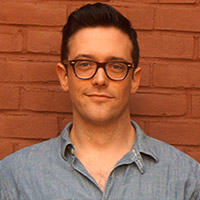 Each of these performances has taught me re-think what I know about art and inspiration, and they are with me every day when I write. In addition to a seemingly never-ending list of books I flip through daily—various back-issues of National Geographic featuring articles about Isle Royale (used as inspiration); a 1937 manual called Wolf and Coyote Trapping; the unbelievably inspiring/gorgeous Atlas of Remote Islands by Judith Schalansky; others—I am constantly harkening back to each performance, remembering them, and making sure that they are not forgotten. And I am reminded with every word I put down how astonishing and remarkable the performing arts are…how important they are to the production of any art.”
Each of these performances has taught me re-think what I know about art and inspiration, and they are with me every day when I write. In addition to a seemingly never-ending list of books I flip through daily—various back-issues of National Geographic featuring articles about Isle Royale (used as inspiration); a 1937 manual called Wolf and Coyote Trapping; the unbelievably inspiring/gorgeous Atlas of Remote Islands by Judith Schalansky; others—I am constantly harkening back to each performance, remembering them, and making sure that they are not forgotten. And I am reminded with every word I put down how astonishing and remarkable the performing arts are…how important they are to the production of any art.”
——
Robert James Russell is the author of two upcoming books: the collection Don’t Ask Me to Spell It Out (WhiskeyPaper Press, 2015) and the novel Mesilla (Dock Street Press, 2015). His first novel, Sea of Trees, was published in 2012. He is the founding editor of the literary journals Midwestern Gothic and CHEAP POP. You can find him online at robertjamesrussell.com and @robhollywood.”
Interested in learning more? Read our interview with Robert.
UMS Artists in “Residence”: Meet Leslie Rogers
UMS launched a new Artists in “Residence” program during the 2014-2015 season. Five residents from across disciplines will take residence at our performances throughout our season. We’ll profile each resident here on UMS Lobby.
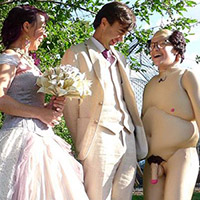 Gabrielle Carels (UMS): Tell us a little about yourself and your background in the Arts.
Gabrielle Carels (UMS): Tell us a little about yourself and your background in the Arts.
Leslie Rogers: I started making my own work, outside of school assignments, with a sewing teacher. I took weekly sewing lessons from age 7 to 11, and understood that sometimes we were making things that did not get used, wall hangings, which piqued my attention. I was interested in the dialogue that went on amongst the quilters and how they articulated their standards of quality. I tried to understand what they aspired toward in their endeavors. I thought of them as mad geometrists who made legitimate fine art. That experience taught me to be perceptive about the things that were happening at the edges of, or on trajectories parallel to, forms that are most clearly and unquestionably distinguished as fine or high art.
Since then, I’ve become involved with puppetry, community pageants, parades, DIY theater, and entertainment in various respects. I pursued institutional degrees in art and sculpture, but always have thought of the cultural production ethos in institutional settings and those present seemingly far outside of the atmosphere of schools, galleries, and museums, as deeply interrelated, mutually establishing a depth of perspective. I think that the more I’m willing to look, no matter where, the more genius I find, and I look forward to those learning opportunities.
GC: Can you tell us a little about your creative process? Where can we find you working on your art?
LR: I work out of a studio on North Campus, in a building with lots of other faculty and graduate student studios, but also travel to collaborate with others or bring them here. I just arrived, so I don’t quite have local collaborators yet, but that is likely to change.
The work that I do alone is more controlled, more researched, more polished, more aesthetically and conceptually clear and calculated. The work I do with others, whether it is one person or 30 people, a piece of street theater, a cabaret performance, wedding, touring play, live internet TV show, or pageant, I try to step back from the kind of controlling roll that is expected in solo work. Instead, I am there to introduce possibilities and see what catches, support proposals by others, allowing the project itself to set its terms as it evolves, for our dynamic to establish what’s best and what needs to happen next. I believe that in a good collaborative dynamic, we’re to avoid the speed bumps created by imposing our individual practice-base objectives and preconceived notions of quality onto the project at the beginning or periodically along the way. Especially in smaller groups, I know my collaborators very well, and tend to work with people that I trust will impulsively take a similar attitude.
Working productively through this ethos with others has allowed me to expand my conception of what is possible in my practice. I’ve done a lot of things and worked in a lot of ways first with others that I would never have come to through working alone, and those possibilities slowly show themselves in my solo work. I find a lot of satisfaction in finding the influence of that chaos in my more controlled individual practice.
GC: What inspires your art? Can you tell us about something you came across lately that we should check out too?
LR: A lot of books I’m reading lately are in some way about the construction of social values. I love Barbara Ehrenreich, Rebecca Solnit, Nicholas Taleb, and Claire Bishop. In terms of fiction, my selections are nearly all humorous and at least a little dark. Lately, I’m loving George Saunders, Donald Barthelme, David Sedaris, Lorrie Moore, and Al Franken.
I really value comedy as contemporary social commentary, able to distill the most confusing and logically or morally slippery cultural phenomena. A lot of the entertainers that I think of as brilliant are very, very funny. Nearly all of the television shows that I follow are on Comedy Central. I laugh a lot, especially at museums and galleries. I’m not laughing with or at the art necessarily, but this seems to be the primary way in which my brain chooses to express that it is stimulated, intrigued, or impressed. It seems out of my control, and is definitely a compliment.
GC: Are you engaged with the local arts community? Tell us about groups or events that we should know about.
LR: I’ve only been here for a month, so an accurate answer to this question would be “not quite yet.” I’ve connected with lots of lovely old friends and friends of friends in Detroit, and a number of people from the U-M School of Art & Design reached out to me even before I visited. Indiscriminately, people in the university community have been extremely welcoming and proactive in involving me with the goings-on, including this residency! I’m really excited to develop the relationships that have come up just in the first month I’ve been here, and attend nearly every performance and symposium.
GC: Which performances are you most excited about this season and why?
LR: I’m really interested in Compagnie Non Nova in February and Lyon Opera Ballet in April. I’m going to teach a course about object performance next semester, covering puppets, masks, costumes, sets, etc. Theater magic, essentially, is at the crux of my practice. Both groups appear to be big on spectacle, visual aesthetics, and narrative told without words. I really can’t wait.
Interested in more? Watch for more artist profiles on UMS Lobby throughout this week.
UMS Artists in “Residence”: Meet Nicholas Gable
UMS launched a new Artists in “Residence” program during the 2014-2015 season. Five residents from across disciplines will take residence at our performances throughout our season. We’ll profile each resident here on UMS Lobby.
UMS: Tell us a little about yourself and your background in the Arts.
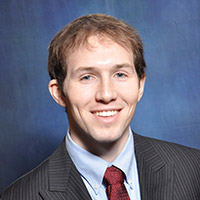 Nicholas Gable: I was born and raised in Ann Arbor, and started taking piano lessons at age 6 from Maria Barna, a local teacher who had studied with Heinrich Neuhaus at the Moscow Conservatory. After Ms. Barna passed away, I began studying with Waleed Howrani, who had studied with Emil Gilels, a student of Neuhaus. I was fortunate enough to have the opportunity to give several concerts while completing a History and Law degree, including an all-Liszt recital in 2011, and I will be playing Rachmaninoff’s Second Piano Concerto with the Grosse Pointe Symphony Orchestra on October 26, 2014.
Nicholas Gable: I was born and raised in Ann Arbor, and started taking piano lessons at age 6 from Maria Barna, a local teacher who had studied with Heinrich Neuhaus at the Moscow Conservatory. After Ms. Barna passed away, I began studying with Waleed Howrani, who had studied with Emil Gilels, a student of Neuhaus. I was fortunate enough to have the opportunity to give several concerts while completing a History and Law degree, including an all-Liszt recital in 2011, and I will be playing Rachmaninoff’s Second Piano Concerto with the Grosse Pointe Symphony Orchestra on October 26, 2014.
GC: Can you tell us a little about your creative process? Where can we find you working on your art?
NG: Pianists are at the mercy of their instrument, which means that most of my work takes place in one room at home. Of course, studying scores away from the piano can also be useful. When I learn a new piece, I start by (re)reading a biography of the composer, because I think it is important to understand the composer and his time. In approaching the score itself, I think it’s important, as Rachmaninoff put it, “to look behind every corner.” Every detail is important, but the structure of the piece also needs to be considered. For a piece like the Rachmaninoff concerto, I also like to learn the orchestration thoroughly.
GC: What inspires your art? Can you tell us about something you came across lately that we should check out too?
NG: All of the great pianists of the 19th and 20th century recognized the importance of a broad cultural education. It is impossible to create art at the piano without any understanding of literature, poetry, and visual art. The pianist Claudio Arrau, for example, in Conversations with Arrau, discusses the Greek myth of Hero and Leander as the basis for Franz Liszt’s B Minor Ballade, and Goethe’s Faust as the inspiration for Liszt’s great B Minor Sonata. When I was in my last year at the University of Michigan, I taught a class on literary inspiration in Liszt’s music to freshmen enrolled in the Honors Program . Rachmaninoff is another good example. It is difficult to appreciate fully the Isle of the Dead or the B Minor Prelude without looking at the respective paintings by Arnold Bocklin that inspired them.
GC: Are you engaged with the local arts community? Tell us about groups or events that we should know about.
NG: I would love to become more engaged with the local arts community. I follow the events at the Kerrytown Concert House, and have played chamber music with local musicians. In June, I played the Franck Violin Sonata with Priscilla Johnson at Kerrytown in a benefit concert for Tracy Van den Bergh, who is running for Washtenaw County Probate Judge. My goal is to become more involved with local artists in all disciplines.
GC: Which performances are you most excited about this season and why?
NG: This season’s schedule is especially rich. I can’t wait for both San Francisco Symphony concerts. I have heard the Mariinsky Orchestra at Hill Auditorium several times, and I’m looking forward to its two concerts in January. Prokofiev’s Piano Concerto 3, featured in the first concert, is an all-time favorite. Denis Matsuev, who is playing in the second Mariinsky concert, is a wonderful pianist. Finally, I am looking forward to the Rotterdam Philharmonic, who’ll perform with pianist Hélène Grimaud.
GC: Anything else you’d like to say?
NG: Thank you for such a wonderful opportunity!
Interested in more? Watch for more artist profiles on UMS Lobby throughout this week.
UMS Artists in “Residence”: Meet Emilio Rodriguez
UMS launched a new Artists in “Residence” program during the 2014-2015 season. Five residents from across disciplines will take residence at our performances throughout our season. We’ll profile each resident here on UMS Lobby.
Gabrielle Carels (UMS): Tell us a little about yourself and your background in the Arts.
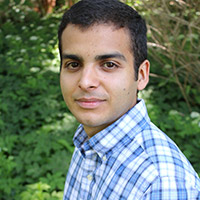 Emilio Rodriguez: My parents would say that I started out as an actor at age 3, doing a one-man adaptation of “The Wizard of Oz” in our kitchen/living room, which consisted of my portraying all of the characters using a broom, my mother’s heels, and a funnel. At age 8, I won an award at my elementary school for a poem that I wrote about Arbor Day. By age 13, I taught myself the basics of piano and music theatre and explored songwriting from books I found at Barnes & Noble.
Emilio Rodriguez: My parents would say that I started out as an actor at age 3, doing a one-man adaptation of “The Wizard of Oz” in our kitchen/living room, which consisted of my portraying all of the characters using a broom, my mother’s heels, and a funnel. At age 8, I won an award at my elementary school for a poem that I wrote about Arbor Day. By age 13, I taught myself the basics of piano and music theatre and explored songwriting from books I found at Barnes & Noble.
Although these were memorable and perhaps defining moments in my artistic endeavor, I would credit the beginning of my artistic training as my time at U.C. Irvine, where I majored in Drama and explored acting, directing, playwrighting, and teaching. I now combine everything I learned as a teaching artist, actor, director, and writer in the Metro Detroit area.
GC: Can you tell us a little about your creative process? Where can we find you working on your art?
ER: I usually have difficulty creating when I block out time to work (or when I refer to my art as work). Instead, the inspiration comes a little more organically. Usually, my creative impulse is triggered by a quote or an image. That usually leads to my staying up until two in the morning on a random Wednesday night because I work in spurts more than at arranged times. Some people might say that my process is similar to an undergrad’s when working on an essay the night before it’s due.
I have been fortunate to have my original plays produced at Two Muses Theatre and Ann Arbor Civic Theatre and to direct with Shakespeare in Detroit, as well as to perform with several Metro Detroit theaters, including in an upcoming performance at Planet Ant Theater (their production of Invasion! running in December). I also perform a play that I wrote about bullying called Sorry at schools all over Michigan through a company that I’ve started on my own. The company is called 64 Crayon Box Arts and also does drama workshops and training (Email: 64CrayonBoxArts@gmail.com).
GC: What inspires your art? Can you tell us about something you came across lately that we should check out too?
ER: Artists inspire my art. I’m always so impressed by the incredible work that is done in Michigan by both large and small performance organizations. I admire artists who create work that is challenging and thought-provoking. I always find that live performances get my creative juices flowing and make me question the world we live in and how we affect it.
Recently, I was moved by a Jamaal May poem called “There Are Birds Here.” It’s a beautiful piece that embraces the realities of Detroit and encourages the reader to look at our city and its experiences through a different lens. The last 3 lines remind me of Nikki Giovanni’s “Nikki-Rosa” as that poem also challenges the ways in which I may place my own standards on to someone else’s lifestyle. “There Are Birds Here” is a statement about why many residents feel Detroit is not a diamond in the rough, but a diamond tried and true. It is one of the reasons that I decided to stay in the area this year, and this idea inspires the choices that I make as an artist by providing a clear focus and purpose to my work.
GC: Are you engaged with the local arts community? Tell us about groups or events that we should know about.
ER: I am an avid supporter of the local theatre scene and am trying to get more involved in the local poetry and music events as well—I should say, the art scene in general as I love both the visual and performing arts.
There are so many theaters I want to recommend, and thus it’s probably best to guide people toward Encore Michigan to keep up with all of the great plays in the area.
For those who have a passion for literature created right here in The Mitten, I encourage exploration of an online magazine called The Periphery created by a few local writers who are creating a network and space for Michigan writers.
GC: Which performances are you most excited about this season and why?
ER: I am thrilled by the entire line-up which features great music, theater, and dance. The Campbell Brothers are bringing new life to one of my favorite albums, John Coltrane’s A Love Supreme. And I’m sure the interdisciplinary techniques of Kiss and Cry will captivate a wide array of audiences. I have to say I’m most excited about Lyon Opera Ballet’s wild re-imagining of the classic tale Cinderella, which looks like it is going to be truly unforgettable.I have so much respect for artists who create bold and innovative work that aids us in reexamining our viewpoints on any issue. This interpretation, which is set in a dollhouse, will indubitably bring us together as an audience through the combination of a universal art form, a timeless story, and childhood remembrances.
GC: Anything else you’d like to say?
ER: I appreciate everyone out there who supports the arts and understands their value to our communities. I hope everyone makes an effort to enjoy the performances UMS offers this season, as well as the performances at theaters, concert halls, and cafes throughout Michigan. Driving may be tedious, but experiencing art is always a reward in itself.
Interested in more? Watch for more artist profiles on UMS Lobby throughout this week.
UMS Artists in “Residence”: Meet Carolyn Reed Barritt
UMS launched a new Artists in “Residence” program during the 2014-2015 season. Five residents from across disciplines will take residence at our performances throughout our season. We’ll profile each resident here on UMS Lobby.
Gabrielle Carels (UMS): Tell us a little about yourself and your background in the Arts.
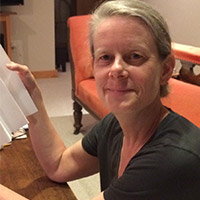 Carolyn Reed Barritt: I studied fine art in college, but for many years afterward I worked as a graphic designer, and then an art director and illustrator. I returned to fine art a few years ago and now exhibit my artwork regionally and nationally. I also teach drawing privately and mentor other artists.
Carolyn Reed Barritt: I studied fine art in college, but for many years afterward I worked as a graphic designer, and then an art director and illustrator. I returned to fine art a few years ago and now exhibit my artwork regionally and nationally. I also teach drawing privately and mentor other artists.
GC: Can you tell us a little about your creative process? Where can we find you working on your art?
CB: I work in ink on paper using nib pens and paint brushes. My drawings and paintings are a combination of abstract shapes, lines and linearly drawn structural elements. I start with either shape and color or drawn lines and then go back and forth adding more abstract shapes, lines and linear structures on top of each other. I spend most of my time in my basement studio.
Photo: “Amusement Park” by Carolyn Reed Barritt. More on Carolyn’s website.
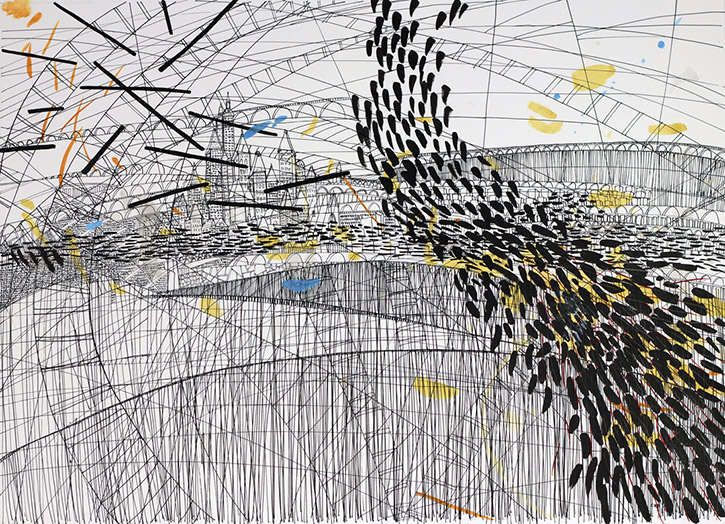
GC: What inspires your art? Can you tell us about something you came across lately that we should check out too?
CB: I look at a lot of aerial photography — mostly historic photos of buildings and landscapes but also contemporary photography — and use what I find as inspiration for my artworks that contain structures. I’m also very inspired by patterns, colors, and images I run across in daily life. A splatter of paint across a road, a group of people waiting for a bus, hay bales in a field, a photograph of a herd of animals, etc. The patterns or colors that present themselves in these mundane moments can become the basis for one of my ink paintings.
Lately I have been watching the motion art of Australian artist Andy Thomas. He creates what he calls “audio life forms that react to sounds.” I also recently ran across the Louisiana Channel, which comes from the Louisiana Museum of Modern Art in Denmark. It has lots of videos about art and culture including many artist interviews.
I have a long list of artists I admire and find inspiring. Recently I’ve been studying the work of contemporary artists Elliott Hundley, Darren Waterston and Lee Bontecou. I am also very happy that I was able to see the ink and animation art of Pan Gonkai at Work Gallery, and to have heard his lecture about the history of Chinese landscape painting.
GC: Are you engaged with the local arts community? Tell us about groups or events that we should know about.
CB: I meet with a small group of artists every 6 weeks or so. We share our artwork and talk about upcoming shows, art, etc. I attend as many art related lectures and exhibits around town and at University of Michigan as I can.
Photo: “Heartland” by Carolyn Reed Barritt.
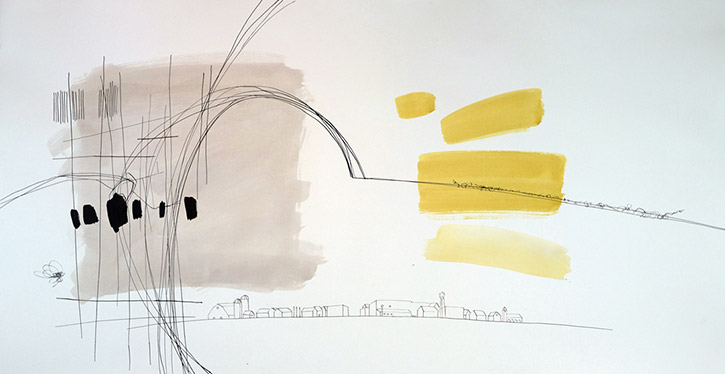
GC: Which performances are you most excited about this season and why?
CB: I’m anticipating the performance of Compagnie Marie Chouinard. I’m curious to see what watching choreographed movement may bring to my artwork, and I’m interested by their piece that is a choreographed version of ink drawings. I’m also excited about seeing Théâtre de la Ville because I’m intrigued by how they will portray the layering of story and character, and the overlapping realities inherent in the drama.
GC: Anything else you’d like to say?
CB: I am curious to see how my attending the UMS performances influences my art. I hope that experiencing the live combination of action, sound and visual stimuli inherent in the performances will spark new ideas about balance, composition and movement which I can bring into my own artworks.
Interested in more? Watch for more artist profiles on UMS Lobby throughout this week.
UMS Artists in “Residence”: Meet Robert James Russell
UMS launched a new Artists in “Residence” program during the 2014-2015 season. Five residents from across disciplines will take residence at our performances throughout our season. We’ll profile each resident here on UMS Lobby.
Gabrielle Carels (UMS): Tell us a little about yourself and your background in the Arts.
 Robert James Russell: I was born and raised in Michigan (Grand Rapids), moved all over the place for a while (Los Angeles; California; Incheon, South Korea; Oxford, England), and settled in Ann Arbor nearly five years ago. I’ve wanted to be a writer since I was younger—although, back then, it was writing for National Geographic—and I’ve spent the majority of my life traveling and reading and writing, trying to hone my voice. I’ve been publishing my work steadily for about five years or so, and my first novel, Sea of Trees, was released in 2012. I also co-founded and run the literary journal and small press Midwestern Gothic. Our aim is to showcase Midwestern writers and poets and highlight the unique stories that come from this place and that are often overlooked.
Robert James Russell: I was born and raised in Michigan (Grand Rapids), moved all over the place for a while (Los Angeles; California; Incheon, South Korea; Oxford, England), and settled in Ann Arbor nearly five years ago. I’ve wanted to be a writer since I was younger—although, back then, it was writing for National Geographic—and I’ve spent the majority of my life traveling and reading and writing, trying to hone my voice. I’ve been publishing my work steadily for about five years or so, and my first novel, Sea of Trees, was released in 2012. I also co-founded and run the literary journal and small press Midwestern Gothic. Our aim is to showcase Midwestern writers and poets and highlight the unique stories that come from this place and that are often overlooked.
GC: Can you tell us a little about your creative process? Where can we find you working on your art?
RJR: I do my best work in public, actually: coffee shops, UMMA, the library…I like to be around people. Since my writing often deals with the intersection of people and places, I find being around people, immersed in them, their interactions, incredibly inspiring. My creative process is pretty simple: When I have an idea for a story, short or long, I can’t stop thinking about it and have to get it out. I’m also all for immersive inspiration…so if I’m writing about the woods, I’ll take trips to the woods, go hiking, take photos, and really get the sense of it. I’m currently working on a novel set on an island in Lake Superior, and went camping this summer on South Manitou Island, completely cut off from the world for a few days, in order to take it all in. It was fantastic.
GC: What inspires your art? Can you tell us about something you came across lately that we should check out too?
RJR: I’m reading John McPhee’s The Control of Nature (for the first time) and find it absolutely fascinating, the idea of man versus nature. The new novel I’m working on is very much a man versus nature type of situation, so reading about real-life incidents of nature reclaiming what was once its own, and how we humans try to control and prevent it, is breathtakingly inspiring.
GC: Are you engaged with the local arts community? Tell us about groups or events that we should know about.
RJR: I am—my journal, Midwestern Gothic, is based in Ann Arbor. We publish writers and poets from all over the Midwest, but we are lucky to also get to know many fantastic local ones, too. I actively put on readings throughout Ann Arbor (typically we have those at Literati Bookstore), as a way for people to meet our contributors and to get to experience Midwest literature and poetry first-hand. It is so important to me to embrace the local art scene, and, fortunately, Ann Arbor’s is fantastic. Similarly, my mission in life is to help showcase the immense talents of Midwestern artists, and to give them vehicles to showcase their work (whether that be live readings, having their pieces published, etc.).
GC: Which performances are you most excited about this season and why?
RJR: eighth blackbird: I’m a fan of organized chaos, and this group seems to thrive on that—playing music from memory, genre-bending performances. For me, seeing all the pieces come together as whole, to see the big picture painted one stroke at a time, is wonderfully invigorating, and it directly relates to the new novel I’m working on—I can’t wait to be inspired by it.
Yuja Wang, piano and Leonidas Kavakos, violin: I’ve always found great beauty in the violin and piano played together, side by side, and I have heard amazing things about these two.
Compagnie Marie Chouinard: Much of my writing is fixated with the idea of space—how we interact within a given space and how spaces interact with us—and dance, people interacting with one another, is a great way for me to explore this idea. Plus, I’ve heard that this company is explosively creative and wonderful.
Jazz at Lincoln Center Orchestra with Wynton Marsalis: I’ve often felt that my writing style is influenced by Jazz structure—the improvisation, the fluidity and the conversational-linguistic feel—so I can’t wait to see this master musician at work.
GC: Anything else you’d like to say?
RJR: I am beyond thrilled and honored to be a resident in the first year of the UMS program. The arts are so important to me, and it’s incredible that I’ll be able to help spread the word and to show the community how UMS is affecting my life and my writing—all while supporting the local arts scene.
Interested in more? Watch for more artist profiles on UMS Lobby throughout this week.



